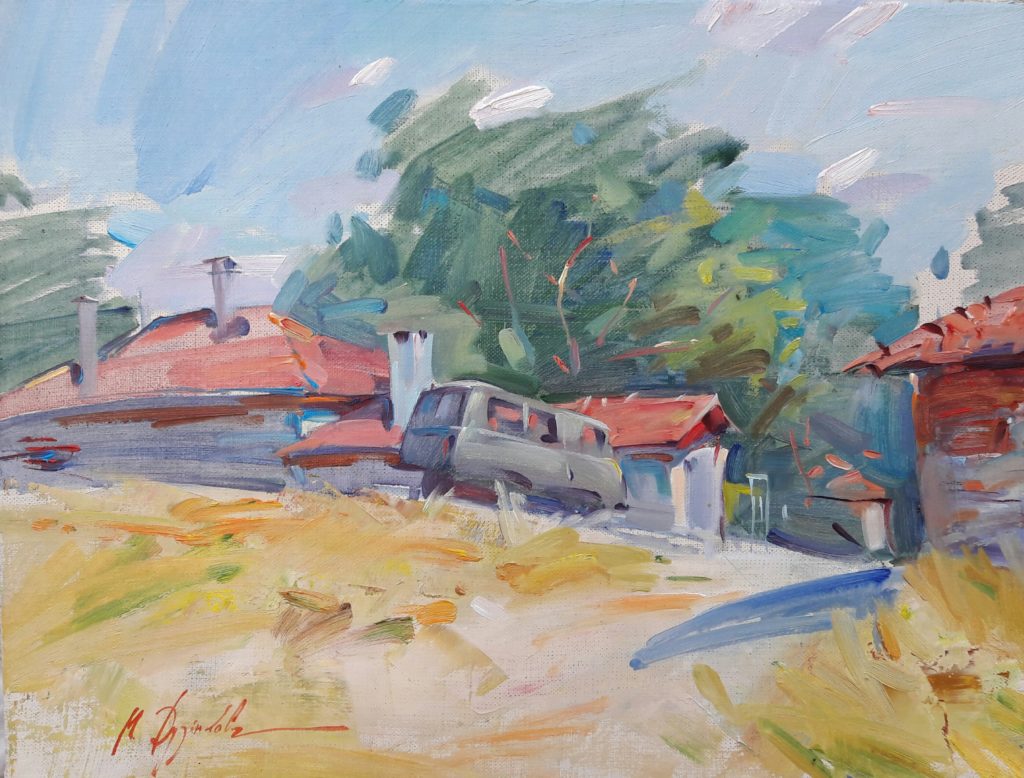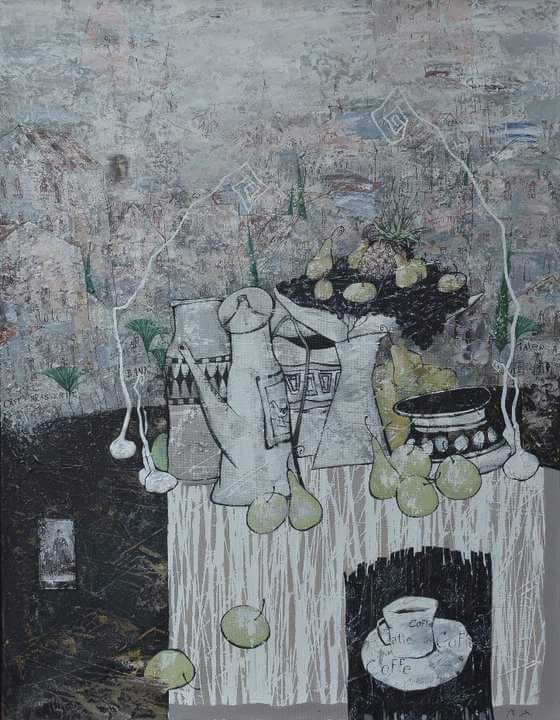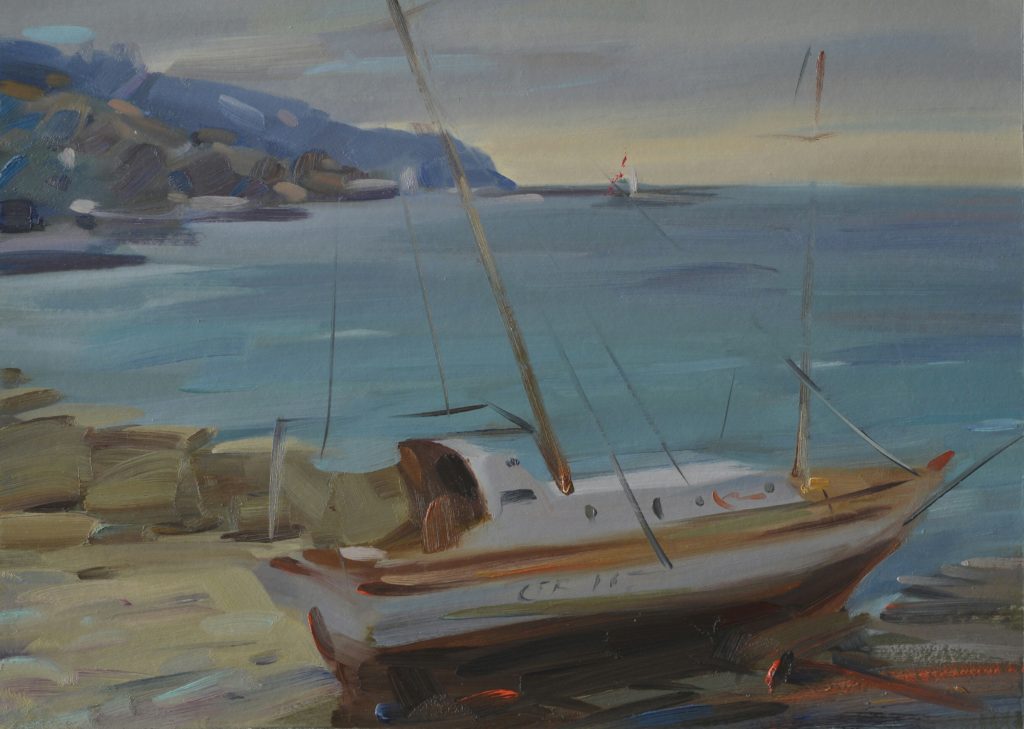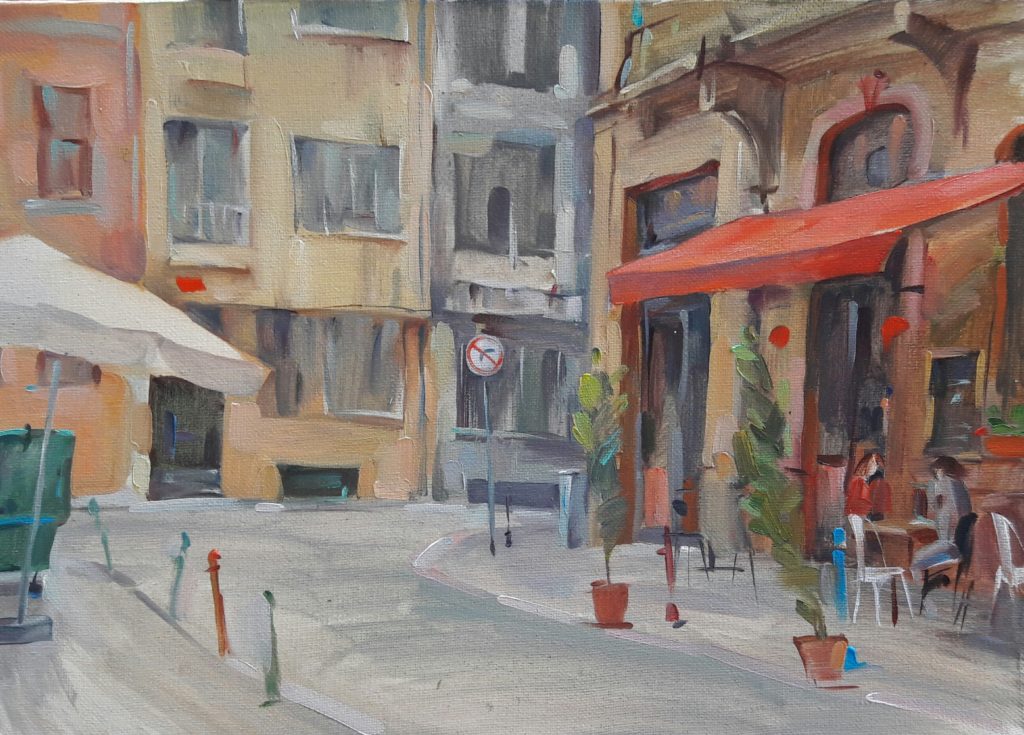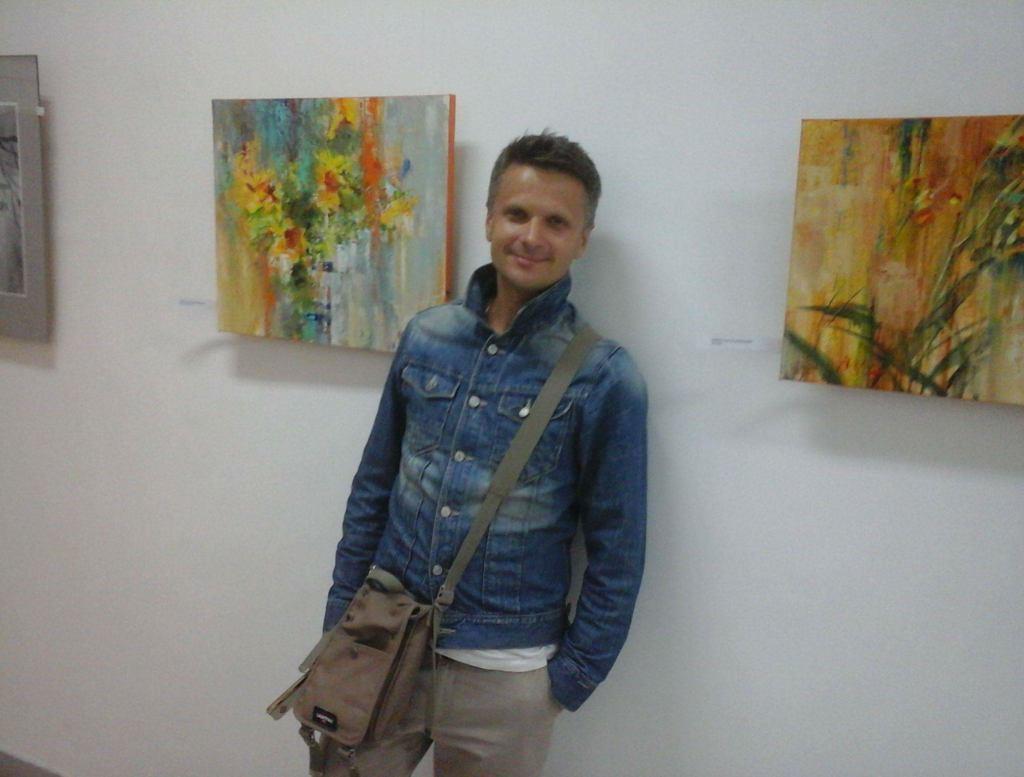A favorite object of consciousness, as an ideal repository of stereotypes, is the image of an artist, a kind of bearded man against the backdrop of a huge window in an unchanging velvet beret, who was deeply thoughtful frozen at the canvas with a palette in his hand at the time of birth that had not yet been created by anyone. His world is the interior of the workshop: a lot of finished and “almost finished work” lying on the floor, standing leaning against the wall, waiting for a better time. The picture of the “universe” is completed by the master’s constant companions – canvases, vases with brushes, tubes of paints, jars of solvents. Beautiful, yes … vital. But it’s very stylized … Our story is about the real world of the master of the canvas … But only – for templates ready for the destruction of heart-sweet …
The workshop of the artist-painter Miroslav Duzinkevich quite lived up to my expectations. Randomly scattered leaflets with sketches and sketches, photographs of paintings that have found their buyers, books and albums, wooden frames covered with canvas and an invariable smell of oil paints and fantasies – an atmosphere of “creative mess”, so enveloping with a creative aura that it’s just right to pick up a brush. But the artist “did not fit into the image” – a young and cheerful guy met me. “So customers sometimes react as well,” Miroslav smiled, seeing my confusion. – When they look at the portfolio, they are eager to make an order, but when they see my photos, they start to doubt: “He is so young!” And meanwhile, I began to fulfill orders already about 10 years ago – from the first year of the academy I have a good idea of how to be an artist”.
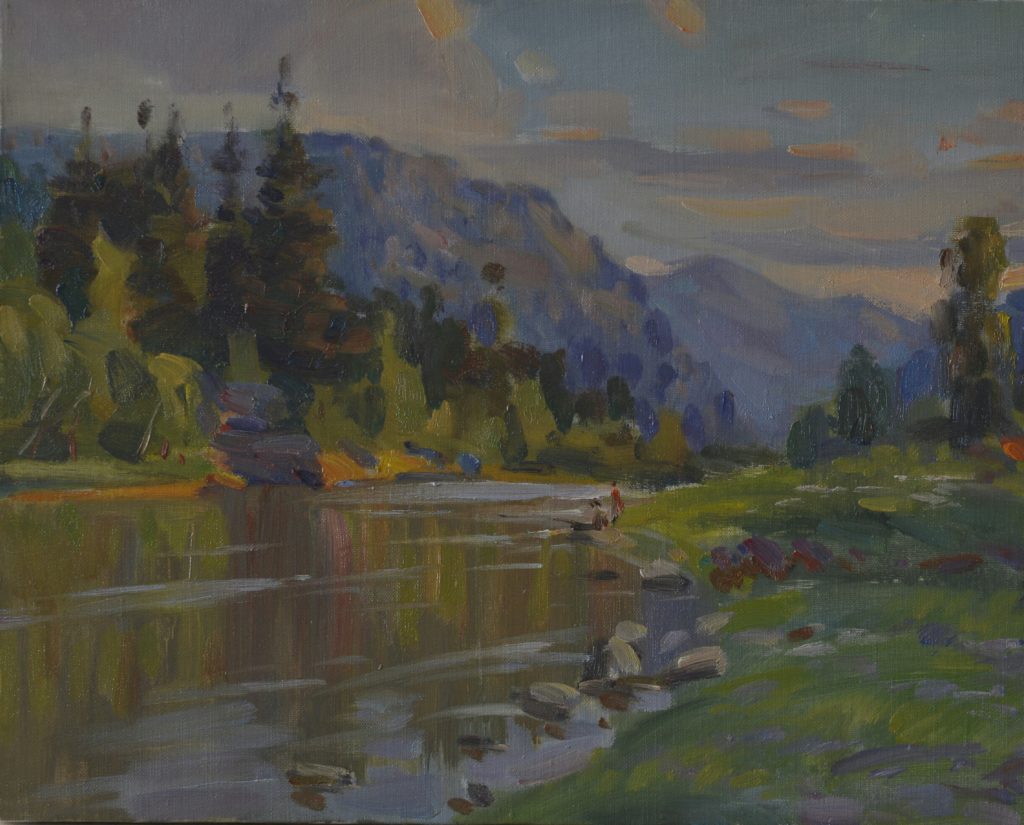
– And what is “being an artist”?
-To someone whose work consists in the ability to color Malevich’s square or write “Masha + Vasya = Love” on an online postcard, it seems that everything is elementary simple: I painted a picture in a month and you can “keep it secret” for the whole life of the banknote. This is actually not the case. According to Pablo Picasso, an artist is a person who writes what can be sold, and a good artist is a person who sells what he writes. For the creator, there are two ways to develop mastery. Or to abandon everything material, and, consequently, from the outside world, close in the workshop and create (but who will succeed in this?). Or, having become rich and famous, to create “reasonable, good, eternal”, without doing orders. I don’t understand the artists standing on St. Andrew’s descent: if you work on the stream, art is transformed into a craft. I prefer to spend 80–90% of my time in the workshop at the easel. On the one hand, I’m glad that you are in demand, but on the other, there is no time for yourself. If in my student days I often could afford to walk or travel with friends, now it’s a luxury. We do not have the concept of a “day off”, in our fast and pragmatic time, customers want a portrait or painting “for yesterday”, regardless of the fact that you can get sick. And at the same time, you need to always have inspiration, which, as you know, does not come from 9:00 to 18:00. Unfortunately, there is no stability in finances. The heavy workload of orders alternates with non-revenue periods. Therefore, almost all of my classmates retrained as designers.
-And you had no desire to drop everything and go to the same computer design?
-I tried to work on the computer “for myself.” But he quickly realized that the soul does not lie in computer design. I don’t understand how you can feel happy creating a work of art using technology. After all, the energy sensation of the picture disappears. For me, the touch of a hand on a canvas, the smell of oil paints – the whole atmosphere of the workshop – is irreplaceable. Not a keyboard or graphic tablet, but pencils and brushes, communication with people gives close contact with the work that is born. Each artist seeks to make his painting light up, so that paints become color, heat, air, and if you have achieved this, then you understand that you are a creator. A computer monitor glows initially, making the search for a common tone impossible. In addition, fans of the creators of computer beauty, unlike connoisseurs of Leonardo da Vinci, Velazquez, Dali or Levitan, will never come to the auction to buy the original. Recently, I first painted the pool under the seashore. This is much more interesting because I like the stylish, creative, tasteful interior. But again, I think that interior design is an applied field. There is nothing more complicated and interesting than painting.
-Why aren’t there so many “free” artists? Does the profession belong to the endangered?
-No, it’s just natural selection. I did not work and did not even study painting in the Soviet era, when the state supported young specialists. But I know firsthand that an artist who successfully painted a portrait of Lenin received a lot of privileges and could never create a single work for his life. Now, young artists have no one to wait for help from, everything needs to be sought for yourself. But I believe that for young people a more promising time has come, providing more opportunities and, finally, the art market has appeared. Businessmen drew attention to the fact that in Europe they acquire paintings not only as works of art, but also as objects of investment. Selling paintings has become a business in which the artist’s perspective is of paramount importance. So, the assets of a modern creator should not only include the ability to draw, but also the ability to present himself, therefore (as in show business) he should invest in creating a brand. And then, as the great ones like to joke, from a certain moment the picture becomes only the background for the artist’s signature.
-But how to realize yourself in a competitive environment?
An ancient truth is close to me: “You must live as if you die at dawn, and work as if you will live forever.”
The contrast in our profession is colossal, I know several artists who lived poorly 5 years ago, and now they are millionaires. But not everyone succeeds in realizing themselves. The disadvantage of education is that even at the academy they do not teach management and business laws. Usually the customer wants one thing, the artist wants another, and the most difficult thing is to find a compromise. No wonder they say that to draw a picture, you need to have talent, but to sell it, you need to be a genius. Of course, personal contacts, recommendations that make it possible to communicate directly with customers play an important role. One of the options for promotion is cooperation with galleries. The second option, the most popular today, is computer design or interior design. But I believe that the most important thing for an artist is a personal or group exhibition: the opportunity to put your brainchildren to the public. It’s a shame when people think it’s easy: I painted, made an exhibition, sold the paintings and woke up as a millionaire. An artist can go to a personal exhibition for 10-20 years, build strategy and tactics, search for and nurture a topic, and only after years will this “shoot a gun”. And before that, to draw well, you need to learn at least 10 years. I chose the hardest way, but, in my opinion, the right one is the path of independence.
-What do customers mostly want?
-Today, interior design is almost unthinkable without a picture: no one hangs carpets on the walls. But it’s a shame that painting is often considered as an element of the interior, a color spot on the background of the wall. A client who is not versed in art acquires a picture for the purpose of a profitable investment, consulting with specialists. If we say on what orders the artist can earn, then this is mainly eclecticism “a la 18th century”. Recently, the owner of the plant ordered a portrait of his daughter, a stylized maximum for the 19th century. And always with a capillary – when the picture looks cracked from time to time. I could not convince him to make a portrait the way I see him, because the girl lives in the 21st century! There are customers who are versed in art, who, while traveling abroad, besides boutiques, visit galleries, the same Louvre, D’Orsay, etc. There are so far no more than 5-10% of them. But in general, the situation for artists is gradually changing for the better – the general educational level is rising, the realistic school of classical art is being revived.
-How necessary is a workshop?
-An artist without a workshop is a bird without wings. This space, which for the creator is his real home, office and library, the world and the microcosm – the space he created, “breathed.” As workshops use both non-residential premises (basements or attics), and apartments. I must say that in some cases, without a workshop, the artist’s creativity is generally impossible. For example, an etching machine – a huge iron press for printing engravings on metal is comparable in size to a piano. Is it possible to put such a colossus in the apartment? And the painter is unlikely to create a masterpiece if he has to huddle in a five-meter kitchen and keep his work under the bed. The workshop was (and remains) one of the privileges, and some workshops are literally inherited. Get a place to work can only members of the Union of Artists. Today, as you understand, the issue with the workshops is very acute, and it is still difficult to predict the development of the situation.
-Why did you choose the profession of an artist?
-I painted from the first grades of the school. My school notebooks were painted with military themes: tanks, soldiers, battles. Mom decided to direct my energy into a “peaceful direction” and agreed on private drawing lessons. After practicing for a year, I realized that I did not want to do anything else in my life. In the 9th grade (after which, as you know, some of the students leave school) we were asked about who chooses which path. Coming out to the board, he openly pushed a speech, which, after 15 years, never ceases to be surprised. I said that in order to become a real artist, you need to have great willpower. But then I did not even suspect how close to the truth. Today, being an artist is a feat. A significant role in my self-determination was played by the personality of Academician V.V. Shatalina, in the workshop of historical painting of which I spent the last courses of the Academy. When I was preparing my thesis, my supervisor was already so poor in health that he could not use public transport. And when on the next Sunday Shatalin came to the academy, who came by taxi to support me, his student, I finally realized that I would not turn off the chosen road.
-How does your family feel about choosing a profession?
-When I was studying at the academy, my parents seriously thought: regardless of whether we want it or not, but in society it is believed that the artist is a poor person. They also say from the word “bad.” My parents wanted me to study law at the same time, but I promised to prove to them that the profession of an artist can bring not only spiritual satisfaction, but also material wealth. I am a very purposeful person and I know that sooner or later, but what you strive for will certainly come. It is only necessary to work diligently all the time and then everyone will be rewarded “according to his labors.”

